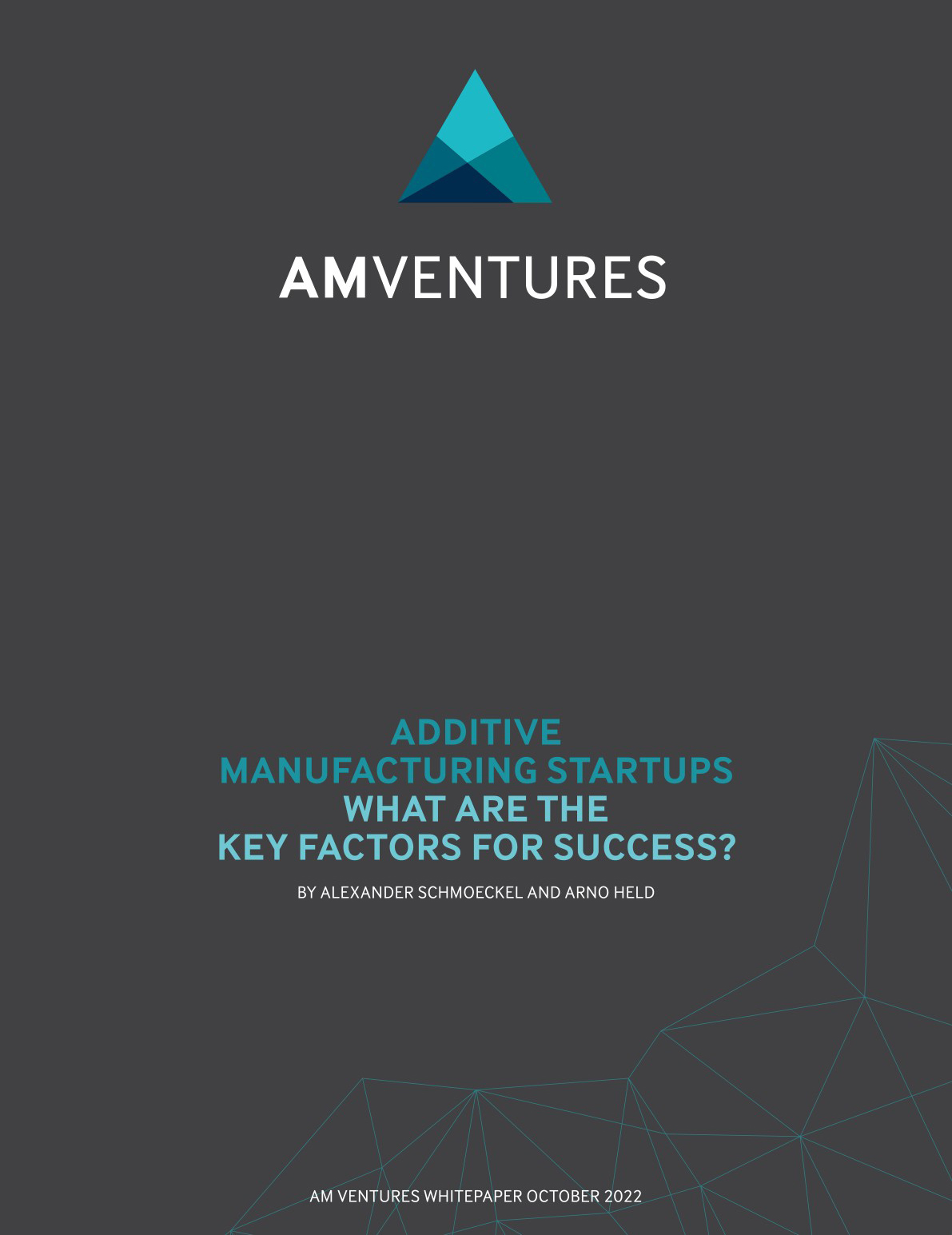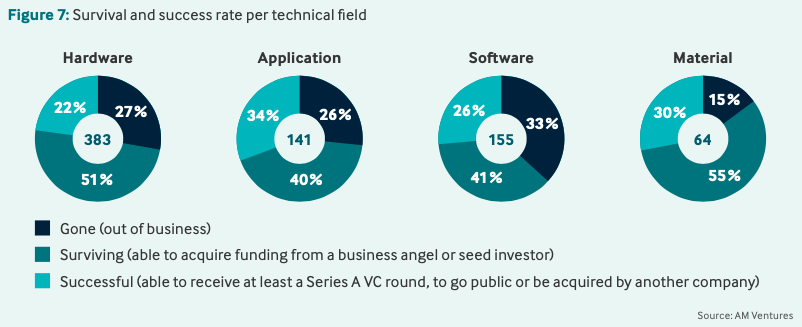German-based 3D printing investor AM Ventures released its latest white paper, titled “Additive Manufacturing Startups: What are the Key Factors for Success?” The paper, now available for free on the 3DPrint.com website, reveals a vision for the future of startup success in the additive manufacturing (AM) industry and provides a comprehensive overview of how AM startups are perceived today.
AM Ventures Managing Partner Arno Held explained, “Our white paper analyzes the database of AM Ventures and aims at improving the likelihood of selecting the best investment targets in industrial 3D printing by evaluating startup success in correlation with the team factor, business model choice and patent protection.”
 Historically, the startup ecosystem has been one of the hottest topics in the industry, with finance specialists focusing on how tough it is to start a new business, the overall survival rates, and how to gain the coveted unicorn status (only 900 globally in 2022), so it’s not surprising that AM Ventures seeks to understand the key factors of a startup’s success.
Historically, the startup ecosystem has been one of the hottest topics in the industry, with finance specialists focusing on how tough it is to start a new business, the overall survival rates, and how to gain the coveted unicorn status (only 900 globally in 2022), so it’s not surprising that AM Ventures seeks to understand the key factors of a startup’s success.
Using AM Ventures’ proprietary database of more than 2,500 startups in industrial 3D printing and data provided by the Master Thesis “Success determinants of digital manufacturing startups: exploring the impact of founder’s human capital, value capture and intellectual property” by AM Ventures Analyst Alexander Schmoeckel, the VC firm then used regression models to test whether the properties that it attributes to ultimate investment success are statistically significant.
As AM Ventures’ white paper identifies, three key elements are directly linked to startup success: a team’s human capital, patent protection, and targeting B2B markets. In addition, the in-depth analysis makes the case that a team with prior founding experience positively influences success in terms of VC financing and firm size, since serial entrepreneurs tend to run better-performing businesses successively.
Aside from the positive influence of human capital, the team’s findings confirm that patent protection positively impacts the likelihood of success. This result is in line with prior studies showing that in complex product industries, such as biotechnology, semiconductors, or information technology, patents are positively associated with the probability of raising funding and the amount of VC the startup receives. Moreover, the study’s authors conclude that patents are a powerful protective mechanism for a startup’s market position.
Another factor that should be on top of the agenda for AM startups is B2B marketing. The reasoning behind this is related to the innate characteristics of businesses, which tend to be more focused on long-term relationships while individual consumers are not. Also, AM technology has a long tradition in B2B markets, requiring less marketing and communication efforts to convince customers to purchase a product.
Another critical finding that arises from the white paper is that application-based startups have the highest success rates in AM. In contrast, material startups have the highest survival rate, and software startups are the most likely to go out of business. Although there is no statistical support in AM Ventures’ white paper for this result other than the company’s own database data, the authors highlight that, for the last three years, they have seen a big shift in their startup database, as the number of application-based startups has grown significantly. From the data, readers can observe that, in 2019, only 27% of the total pool of AM Ventures startups (220) were application-based businesses. However, that number grew significantly by 2021, when 47% of the total startups (840) focused on AM applications.
Furthermore, the research ascertains that there is no statistical relationship between the region where the startup originates and its likelihood of success. Also, while the business model design chosen by a startup had been originally considered a valuable resource, the white paper finds no significant relationship between business model choice and success.
Speaking on the publication of the white paper, Schmoeckel suggests that one of the most critical aspects of entrepreneurship is framed in the reasons why some startups succeed and others fail.
“Identifying the factors that are key for the success of such companies enables entrepreneurs, their advisors and investors to draw their own conclusions and better assess their ventures accordingly. Not much research has been dedicated to the factors influencing the success of ventures in the field of additive manufacturing,” pointed out Schmoeckel.
Undoubtedly, this document sheds light on the AM startup ecosystem and maps out how 3D printing startups can attain success. As an investment partner and leading VC firm, AM Ventures also shows readers a glimpse into its evaluation methodology for potential new ventures, how the firm measures success, and the critical factors it looks for in startups. Since its foundation in 2015, the 3D printing-focused venture capital firm has made very smart investments, such as DyeMansion, Elementum, and Scrona, thanks to its multimillion-dollar fund. With startups playing a vital role in the development of 3D printing technology, the insights from this research are relevant for AM practitioners and entrepreneurs alike.
You can download the AM Ventures white paper for free here.
Subscribe to Our Email Newsletter
Stay up-to-date on all the latest news from the 3D printing industry and receive information and offers from third party vendors.
You May Also Like
Gorilla Sports GE’s First 3D Printed Titanium Cast
How do you help a gorilla with a broken arm? Sounds like the start of a bad joke a zookeeper might tell, but it’s an actual dilemma recently faced by...
Nylon 3D Printed Parts Made More Functional with Coatings & Colors
Parts 3D printed from polyamide (PA, Nylon) 12 using powder bed fusion (PBF) are a mainstay in the additive manufacturing (AM) industry. While post-finishing processes have improved the porosity of...
$25M to Back Sintavia’s Largest Expansion of Metal 3D Printing Capacity Since 2019
Sintavia, the digital manufacturing company specializing in mission-critical parts for strategic sectors, announced a $25 million investment to increase its production capacity, the largest expansion to its operations since 2019....
Velo3D Initiates Public Offering in a Bid to Strengthen Financial Foundations and Drive Future Growth
Velo3D (NYSE: VLD) has been among a number of publicly traded 3D printing firms that have attempted to weather the current macroeconomic climate. After posting a challenging financial report for 2023,...
































